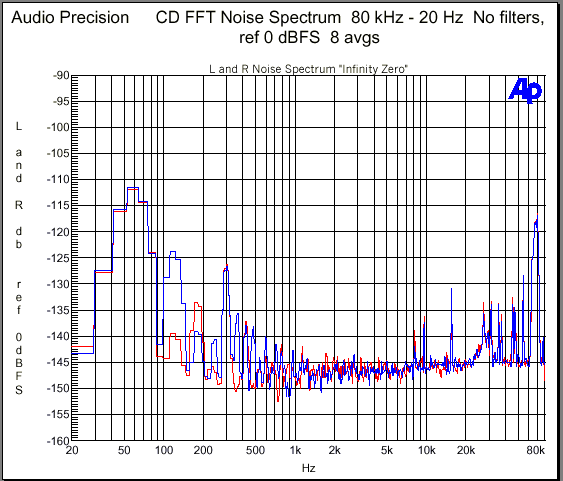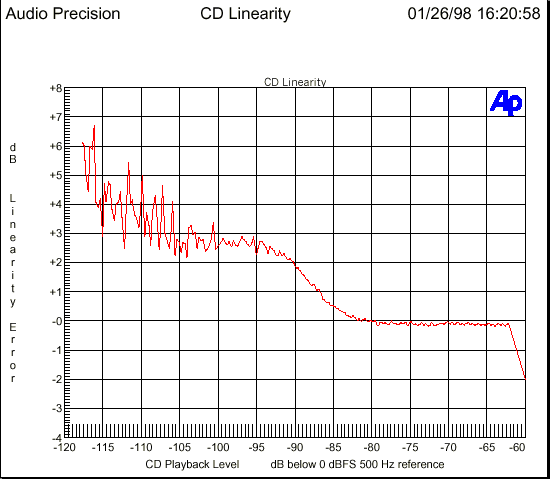DVD Benchmark - Product Review - Marantz DV-7000 DVD Player - November, 2000 Staff
Background
This is the first Marantz DVD player we have seen. We tried to obtain the THX Ultra version for the benchmark, but we were unable to.
Anyway, here are our test results:
Video
The overall video quality of the Marantz is OK to good. Its video frequency response is a little peaked, which adds ringing to the image, but its noise levels are lower than many of its peers.
The Marantz CAV outputs are improperly labeled Y'Cb'Cr', and they are using the inferior RCA connectors.
Black and White Levels
Format Black White Comments CAV 8.0 100.0 The black level is 0.5 IRE too high. This is one of two players we tested that has the highest black level. White is dead-on. YC 8.0 100.7 The YC levels closely match the CAV levels. Color Bars
CAV
The Y portion of the CAV just about matches Betacam ® and EIA 770.1 Levels. They are dead on at white, and as they move towards black, the Marantz stays just a tad above them.
The PB portion of CAV closely matches the SMPTE/EBU levels. The Pr portion of the CAV closely matches SMPTE/EBU just like the Pb signal.
Component Analog Video Data
YC
The Y portion of the YC signal is just a little hot (too high) compared to SMPTE 170M.
The chroma level coming out of the player is a little hot. You will most likely need to turn down the color control. (This is under the assumption that, in the default position, your TV is properly decoding SMPTE 170M.) The chroma phase is perfect, which means you should not have to adjust your tint control. (This is under the assumption that, in the default position, your TV is properly decoding SMPTE 170M.)
Composite/YC Data
Video Frequency Response
The Marantz displays ringing around objects. The frequency response dips down just slightly up to 3 MHz, and then it rises above the 0 line up to 0.36 dB at 5 MHz. The picture will appear sharp but on close inspection you will see the ringing.
The CAV output is slightly sharper than the YC. The difference is so small it may not be noticeable at all. They track each other very well. There is ringing on the Avia sharpness pattern.Video Frequency Response
Pixel Cropping
Location Pixels Comments Top 0 Excellent Bottom 0 Excellent Left 5 Very Good Right 0 Excellent Signal-To-Noise Ratio
Format Output SNR (dB) Comments CAV Y -60.0 OK - This player falls on the bottom end for CAV SNR. CAV Pb -66.9 OK CAV Pr -68.5 OK YC C-AM -66.0 Very Good YC C-PM -64.0 Very Good Component Channel Timing
Channel Timing (ns) Comments 'Pb' to Y 2.4 Very Good 'Pr' to Y 2.1 Very Good 'Pb' to 'Pr' 0.3 Excellent Audio
Audio Frequency Response
The Audio Frequency Response on the Marantz DV-7000 was excellent, plotting as flat as a ruler would from 20 Hz to 5 kHz, with a very slight, yet smooth and gradual taper on the high frequency side. This implies not only accurate tonal response, but a well-implemented filter both in the digital reconstruction filter, and its analog counterpart. In terms of relating performance to the other players, the DV-7000 performed among the best in this regard.
Audio Frequency Response
Harmonic Distortion + Noise FFT
The Harmonic content of the distortion products was fairly good, but not extraordinary. The largest harmonic, as shown below, was the 3rd, at 3 kHz. The distortion products above that did fall substantially below that level, although they did not fall in amplitude as frequency rose, as we would have liked, i.e., the 15th harmonic is at the same level as the 5th harmonic. However, the higher order distortion products were low in an absolute sense, which is of course a good thing.
Distortion Spectrum
Wide-Band noise spectrum FFT (Wall AC)
We should mention that despite a previous incorrect statement (we corrected it in the explanatory article) that RF shown by this test may be caused by DACs, the D/A converters have nothing to do with the noise floor in this test, as they are running “infinity zero,” meaning that they're outputting nada.
The overall noise floor, shown below, was quite low with the DV-7000, with the highest levels at peaks around 60 Hz and 80 kHz, both –110 dB below full scale output. There were also some noticeable peaks at harmonics of the 60 Hz AC supply, most likely caused by ripple in the power supply somehow leaking into the signal path. We could speculate that the spikes at higher frequencies could be caused by noise from the display, or internal noise caused by processors, or the transport servo motors, or whatever. Spikes are not a desirable thing in a noise floor, but considering that other than the 60 Hz peak at –112 dB, everything else in the audible band is at –125 dB or lower, we can't really feel very justified complaining a whole lot about it.Noise Floor (Wall)
Wide-Band noise spectrum FFT (Lab grade AC)
The lab-grade 60 Hz power supply feeding the player didn't change much of the noise content, implying that power line conditioners will be of little benefit in terms of audio performance with this player, so that whatever noise that is present, is inherent to the operation of the player. This would be a bad thing if the noise floor were substantial and needed real improvement, but that's not the case. The noise floor is quite respectable with a regular AC wall socket. That's not to say that AC grounding differences can't affect the noise floor, but that if there is a difference, it's not likely to be because the AC itself is cleaner. The plots between a standard wall socket with all its noise, and the lab grade AC supply, are pretty much identical.
Noise Floor (Lab)
Low-Level DAC LinearityWith the DV-7000 doing so well in other regards, the low-level DAC linearity was a bit disappointing. It was heads above the APEX, although linearity began to deviate at –85 dB, was +1 dB high at –87 dB, and hit + 2 dB of error at –90 dB, but still kept within 3 dB of linear past –100dB. Not horrible, but just not state of the art by a long shot. This isn't going to mean much with popular recordings, which compress the begeezus out of everything to keep almost all the content in the top 20 dB of the dynamic range, but it does mean that the DV-7000 cannot fully exploit standard 16-bit resolution, let alone take full advantage of 20 or 24 bit recordings.
DAC Linearity
Dynamic Range
96.4 dB. Dynamic range was fine, complements of the low analog noise floor, and apparently relatively quiet DACs.
Inter-Modulation Distortion
-114 dB at the SMPTE standard, which is good.
Functionality
Note: A green check in the boxes below means that feature worked OK. A red X means it is unsatisfactory.
Avia
Test Results Comments Subpicture
Slide Show
Can't pause or navigate backwards. (Chapter Previous) Video Essentials
Test Results Comments Blacker-Than-Black
Stress Test
WHQL
Subpicture Palette (DCS)
Test Results Comments Still
Bob
Weave
Default Palette Color Index
Test Results Comments Still
Bob
Weave
Custom Palette Color Index
Test Results Comments Still
Bob
Weave
Branching
Test Results Comments Seamless Branching
This player is capable of doing it in 2 sweeps, which is perfect. Multiple Angles
This player is on the slow end of changing angles. It takes from 1.5 seconds to 2 full seconds to change angles. Menu
Test Results Comments Loops
Ends
Field/Frame Freeze
Test Results Comments Weave
It shows a valve when paused. This is OK, but it is not preferred. Bob
16x9 Menu
Test Results Comments Letterbox
Widescreen
Cropping
Test Results Comments 352x240
Display OK, but when you exit, the player stops and goes back to Marantz splash screen. (I would call this a crash.) 720x480
704x480 352x480 Display OK, but when you exit, the player stops and goes back to Marantz splash screen. (I would call this a crash.) Layer Break
This was the slowest player we tested. It takes 2.5 seconds – 3 full seconds to change layers.
Test (DVD) Results Comments "Cruel Intentions"
"Ghostbusters"
"Friend" VCD "Saving Private Ryan" (DTS) "The Abyss" Chesky Super Audio 96/24 You can select 96 kHz on the digital output or down convert to 48 kHz. Physical Response
This was the slowest responding player around. We gave it a 1, worst performance of any player I have ever seen!
Test Results Comments Setup
Transcode
This player offers the ability, but we were unable to test it. CD-R Error Correction/Concealment
Pierre Vareny
The DV-7000 is able to read a gap up to and including 1.50mm, which is track 33. With the exception of two players, this player falls on the high-end (good) of CD error correction/concealment.
Scratch the Dog
The Marantz was unable to read the disc at all. We never got anywhere. It does fall at the bottom when it comes to DVD player error correction.
Usability
The Remote Score = 6 out of 11. The image gives you an indication how the Marantz designers have considered the usability of the remote.
We established our rating scheme in the usability article with the Eleven Tenets of Remote Design. Each one of those principles gets the player 1 point, so the maximum possible score would be 11. See the comments for each of those design tenets.
Test Results Comments Button Access
The remote is a great size, and you can easily reach most of the core buttons without readjusting your hand. The most important buttons (i.e., the transport controls and the arrow keys) are centered in the middle of the remote where your thumb naturally rests. Minimal number of buttons
While the most important buttons are well placed, there are too many buttons on the remote. This remote could have benefited from a sliding panel like the Toshiba remotes. Distinctive buttons Generally the buttons are unique and are easily differentiated by feel. As we mentioned above, the spacing of the buttons allows you to feel the differences among the buttons. Appropriately sized buttons Generally yes . . . for the buttons we mentioned above. Every other button is packed together. Good tactile feedback
The buttons do not have a good feel when pressed. Good remotes have a distinct feel when the buttons are pressed. You start to press the button and there should be a clear “give” when the button is pressed. Fits well in a single hand
This is one of the best remotes we used with regard to size and fit in the user's hand. The shape of the sides and bottom of the remote make it sit in perfect position. Right/Left Handed Because the remote is narrow through the middle where the majority of controls are, it is easy to reach the buttons using either hand. Backlighting Backlighting is a good option when the designers have gone a bit crazy on the number of remote buttons. The Marantz remote has used different color plastic for the arrow keys and menu buttons. When we first saw the remote, we expected that these buttons would glow in the dark. Glow in the dark buttons are like the poor second cousin to backlighting, but it is better than nothing. Indication of control mode
Standard naming
There are a couple exceptions to the standard naming convention that most remotes use. One of the buttons that controls the menus is “Return.” This button would be better labeled “back” or “exit.” Player feedback
The Bottom Line
This remote did pretty well overall, and the player has nice audio response but a little too much ringing in the video.
- Staff -
DVD Benchmark Explanatory Articles Part 3 - Functionality Part 4 - Usability Part 5 - Progressive Scan
© Copyright 2000 Secrets of Home Theater & High Fidelity
Return to Table of Contents for this Issue.

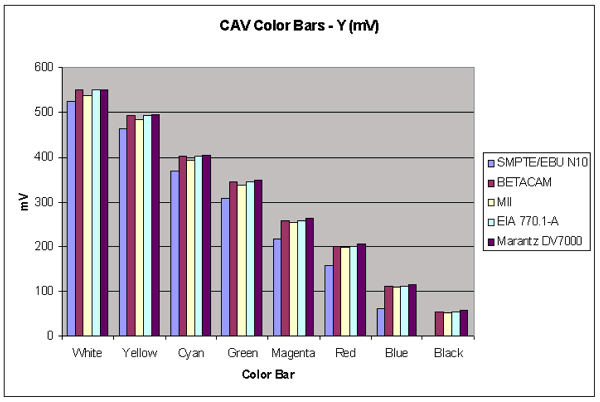

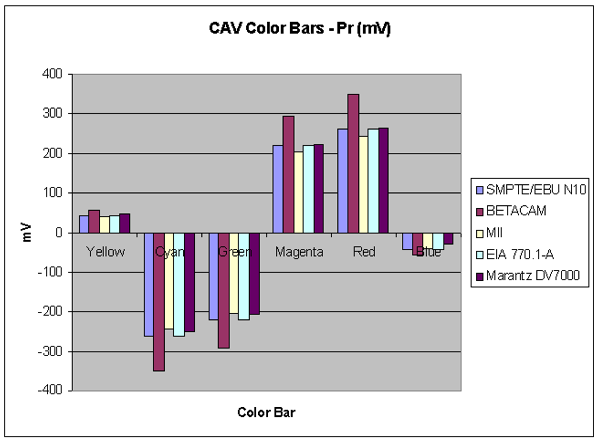
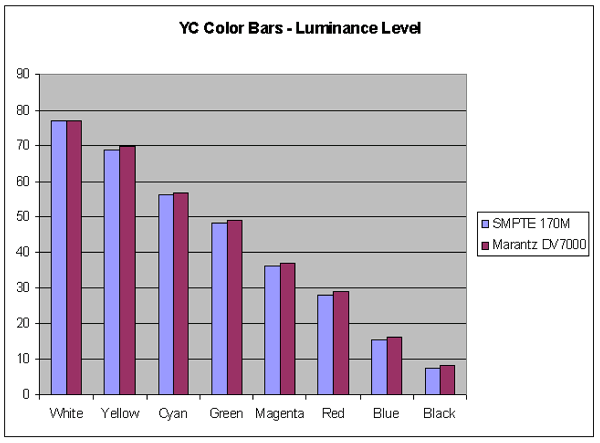

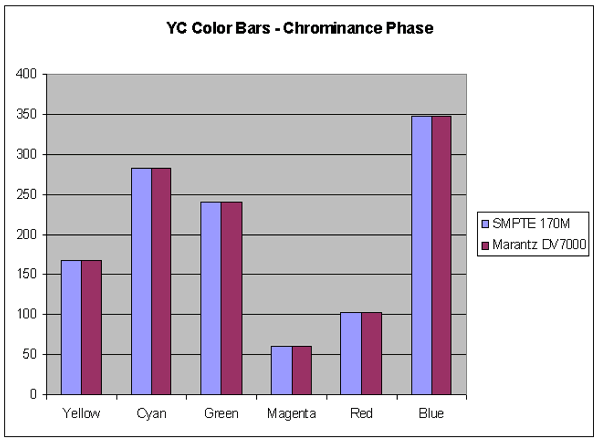



.gif)
